When you think of foraging for wild berries, you probably picture lush landscapes like that of the Pacific Northwest. It may surprise many to know that Arizona has quite a few varieties of wild berries that thrive in its arid and rugged environment. From the enchanting Sonoran Desert to the breathtaking Mogollon Rim, there are numerous opportunities to discover these delightful fruits.
Exploring the great outdoors of Arizona is an adventure in itself, and while hiking through its diverse landscapes, one can stumble upon nature’s hidden treasures. Foraging for wild berries in Arizona not only provides a unique culinary experience but also offers a chance to connect with the land and its native plants.
Among the edible wild berries in this state, you’ll find Oregon grapes, wild blackberries, wild raspberries, mulberries, juniper berries, Saskatoon berries, lemonade berries, and wolfberries.

Edible Oregon Grape in Arizona:
While the Oregon Grape is primarily associated with the Pacific Northwest, it can also be found in certain regions of Arizona. This shrub, known for its vibrant yellow flowers and clusters of tart berries, offers a unique foraging experience.
Oregon grape has a difficult time with the Arizona sunshine. If the plant is protected from the western sun, you may find it growing around the cities of Phoenix and Tucson. Otherwise, you’ll find this plant growing natively at higher elevations in mountainous regions of Arizona. These shrubs thrive in cool, moist environments. Seek them out along hiking trails or in wooded areas, where they can be nestled among other native plants.
Oregon Grape is a small evergreen shrub with spiny, holly-like leaves that are dark green and glossy. It produces bright yellow flowers in the spring, which later give way to clusters of tart, purple berries. The berries are small and round and typically ripen in the mid to late summer. You’ll know they are ripe when they are a dark blue color and pull free of the bush with only a gentle amount of pressure.
Oregon Grape berries have a tart, sour taste that is reminiscent of citrus. While they are not usually eaten fresh due to their acidity, they can be used to make preserves, jellies, or sauces. Native Americans in the region have traditionally used Oregon Grape berries for culinary and medicinal purposes.
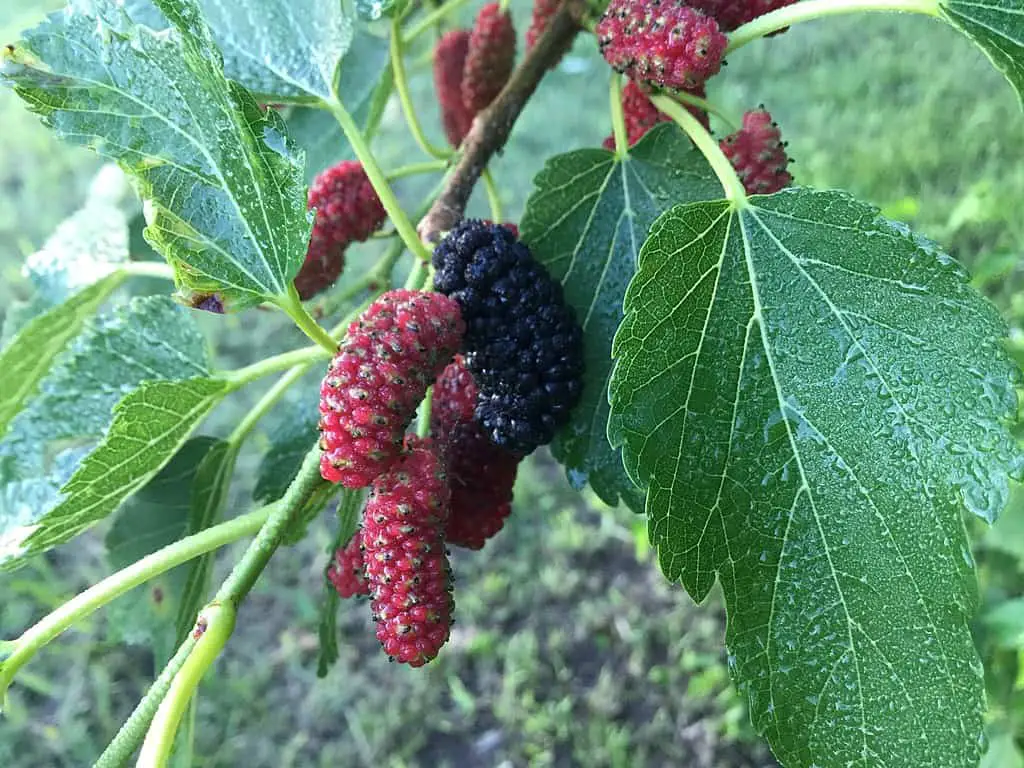
Mulberry Trees in Arizona
Mulberries are small fruit that is not technically a berry. However, they are enjoyed like other edible berries and have a berry-like appearance. These sweet fruits are dark purple when they are fully ripe. They can be eaten fresh or used in pies, smoothies, or jams. Mulberry trees provide a delightful opportunity to enjoy a seasonal bounty during their harvest period. They are one of the great treats for foragers in Arizona.
These trees can be found in various regions of Arizona, particularly near locations with more moisture. Mulberry plants are medium-sized deciduous trees with distinct lobed leaves. They bear clusters of small, dark purple or black fruits when ripe. Look for these trees in riparian areas with access to water, such as near streams, ponds, or even in urban parks and gardens.
When harvesting mulberries, wait until the fruits are fully ripe, as they tend to have the best flavor at this stage. Gently pluck the fruits, being careful not to crush them, as they can be quite delicate. Some people prefer to lay a tarp or a sheet underneath the mulberry tree and shake the branches. This way, the ripe ones will gently fall from the branch, and the rest will stay to ripen.
You can start looking for mulberries to harvest in Arizona in the middle of June. They may be around through the month of August.

Wild Raspberries
In the cooler regions of Arizona, such as the higher elevations of the Mogollon Rim, adventurous foragers can find wild raspberries and wild blackberries. In the Mogollon Rim region, you will typically find wild raspberries in early July. The wild blackberries ripen a few weeks later.
These native berries thrive in acidic soils and are prized for their flavor. Their delicate, jewel-like fruits make for a delightful treat while hiking through the wilderness. They look very similar to the red raspberries you’re familiar with in grocery stores, though they may be slightly smaller and they are often sweeter. Lots of locals love to pick wild raspberries, freeze them, and add them as the main flavor for homemade ice cream.
When you’re looking for wild raspberry bushes, be aware that they grow close to the ground. Also note that occasionally, when there was a harsh winter, the raspberries ripen up to a full month later than normal. There have been years where wild raspberries ripened in September.
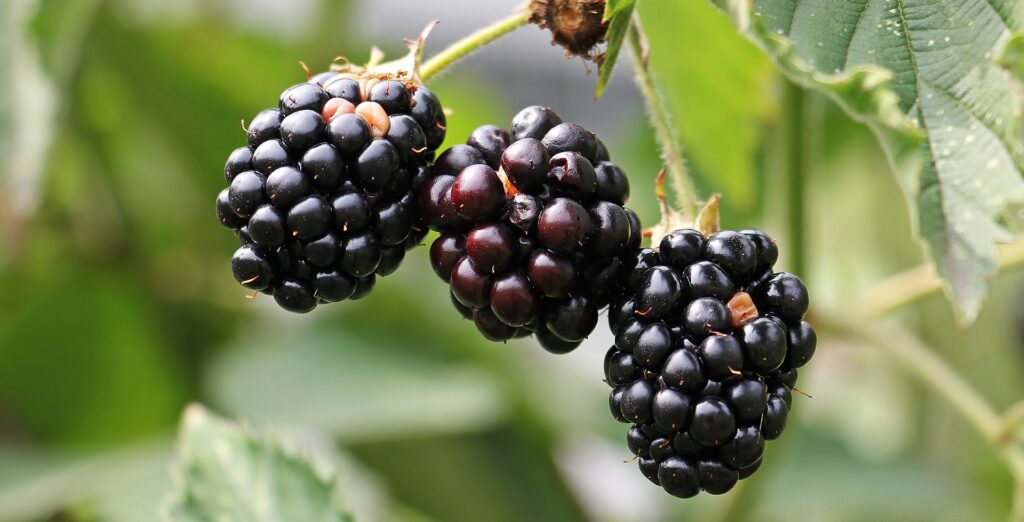
Wild Blackberries
While blackberries are more commonly associated with the Pacific Northwest, they can also be found in Arizona’s high-elevation regions. These areas offer the ideal conditions for wild blackberries to thrive, with cooler temperatures and slightly more moisture. They are more plentiful than wild raspberries, though they often grow where raspberries do as well.
Explore hiking trails and wooded areas in higher elevations, such as the Mogollon Rim and mountainous regions. Look for blackberry bushes along the edges of meadows, near streams, or in shady areas. These regions provide the optimal conditions for blackberries to grow.
Wild blackberries typically have clusters of small, round berries that are dark purple to black when fully ripe. The berries are glossy and have a slightly tart yet sweet flavor. Observe the leaves of the blackberry plant, which are typically composed of three to five oval-shaped leaflets. These jagged-edged leaflets have a vibrant green color and are covered in fine hairs. Familiarize yourself with the distinct leaf structure to differentiate wild blackberry plants from other species.
Keep in mind that wild blackberries grow on thorn-covered vines. There may also be poison oak in the area. Make sure that you are wearing jeans that cover your entire leg. It’s also a good idea to wear thick gloves. Be aware of what your skin is touching so you don’t get cut or get a rash from the poison oak. If you have pets or children with you, you will need to watch them carefully.
In a typical year, you can harvest blackberries from late July through August. You may find some still around well into September.
Once you’ve successfully located a patch of wild blackberries and identified them correctly, it’s time to savor the delicious fruits of your labor. You can happily indulge in the simple pleasure of eating ripe blackberries straight from the bush. Their natural sweetness and juiciness are unparalleled, offering an explosion of flavor with every bite. Rinse the berries gently before enjoying them to remove any dirt or debris.
Wild blackberries can enhance a variety of culinary creations. Use them in pies, cobblers, jams, or preserves to capture their essence and preserve their flavor for future enjoyment. Add them to smoothies, yogurt, or salads for a burst of sweetness and a vibrant touch to your meals.
You may find an abundance of these delicious berries if you’re very lucky. If this happens, consider freezing them for future use. Place them in a single layer on a baking sheet and freeze until solid. Transfer the frozen berries to airtight containers or bags, and they’ll be ready to use whenever you crave a taste of summer.
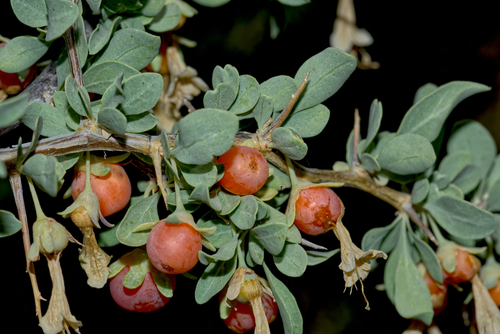
Wolfberries
Wolfberries are a common find in Arizona, even on trails right outside of central Phoenix. Often, foragers familiar with wolfberries will simply call them goji berries, but that’s a misnomer. Wolfberries and goji berries are part of the same berry family: Lycium. They have the same bright red color and the same taste. Goji is a type of wolfberry but isn’t one you’ll likely find in Arizona.
With that distinction noted, the reality is that if you like goji berries, you’ll enjoy Arizona’s plethora of wild wolfberries. These bright orange-red berries have the same taste, are nutrient-dense, and are packed with antioxidants. These desert plants can be up to ten feet tall. It is a woody shrub that has very fleshy leaves. Once the berries ripen, you may notice the leaves dying off. This is because this bush will divert all its resources to keeping the berries healthy and will neglect its own leaves. If there have been recent rains, like in monsoon season, you’ll find the bush to be dense with leaves. Note that there are also thorns on this shrub, though they are not particularly sharp.
The wolfberry shrub may have flowers on it for most of the year. The flowers will be light to dark purple. The best blooms are spotted in November through March. In mid-spring, often in March, the berries will form. They will ripen in mid-summer through late fall.
Wolfberries are sweet, bright red, and juicy. If you’re hoping to harvest them, you will be competing with birds for the best ones. If you spot one shrub near the trail, you may want to walk a few feet into the desert. Where there is one, there are usually more nearby.
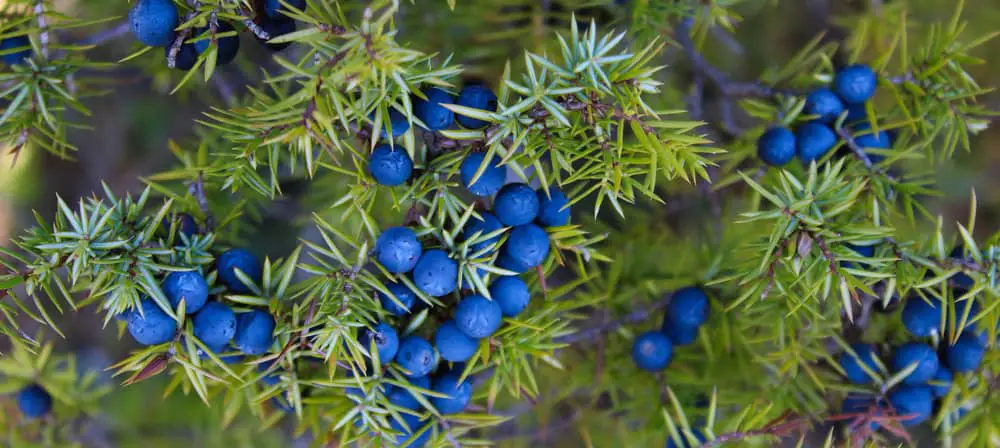
Juniper Berries
The berries from juniper trees (Juniperus communis and several other species) are edible and have been used for food, medicine, and flavoring since ancient times. There are some important things to keep in mind about consuming these berries, however, and anyone considering ingesting them should make sure they know what they’re doing. If not properly identified, some types of juniper can be toxic to humans.
Juniper berries are the fruit of seed cones on junipers, which are evergreen shrubs that grow worldwide. They are a deep blue color with a resinous and woody scent that can be sharp or floral, depending on the species of juniper. They are the seeds of a coniferous tree, and their unique flavor comes from terpenes, compounds that give plants their fragrance and flavor.
A sprinkling of juniper berries can add a fresh, piney flavor to meat dishes and marinades. They are commonly used in northern European and Scandinavian cuisine to season wild game meats like pheasant, other wild birds, venison, and boar. They can also be added to a variety of soups, stews, and chilis for a rustic touch.
The juniper berry is high in powerful antioxidants, which help reduce inflammation and cell damage. The essential oil from juniper berries contains many powerful compounds, including alpha-pinene, beta-pinene, limonene, and myrcene. These natural plant oils have been shown to increase the activity of enzymes like catalase, glutathione peroxidase, and superoxide dismutase, which help protect cells from free radical damage.
Are Juniper Berries Edible? – Krebs Creek
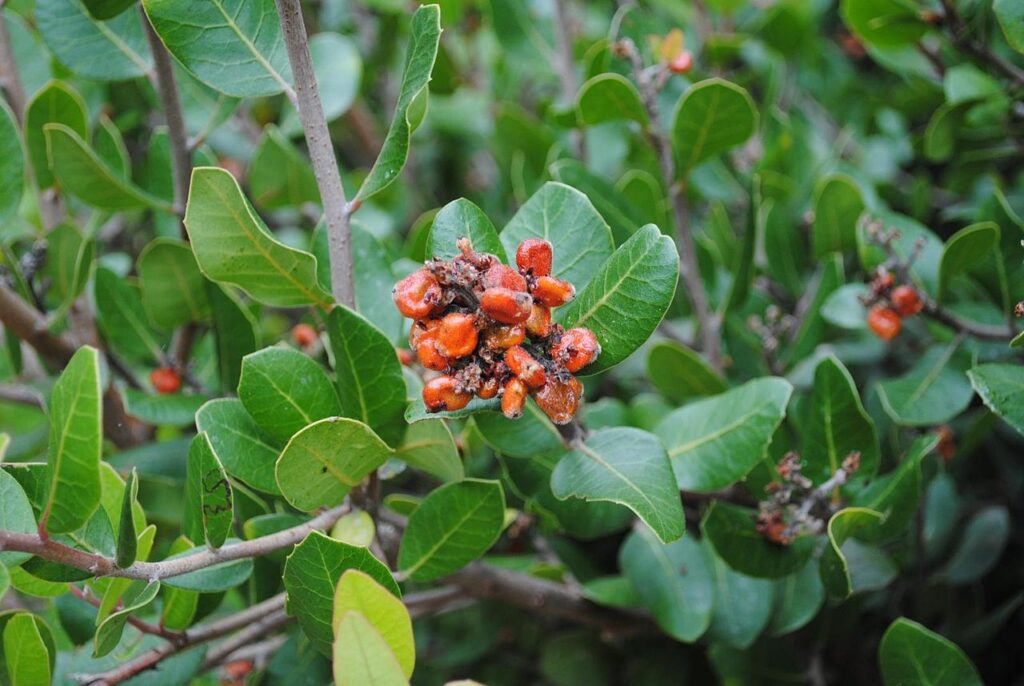
Lemonade Berry
Lemonade berries (Rhus integrifolia) are a common evergreen shrub that may be found along the Arizona and Southern California border in the canyons and other dry areas. Like other members of its genus, this small tree is hardy and can endure extreme drought. Its thick, waxy leaves reduce transpiration, allowing it to remain green even during our long summers. The plant produces tiny, clustered pink to white flowers in winter through early spring, and its fruits are the size of pomegranate seeds with a pale coating that tastes sour, similar to lemonade, which gives it its name.
The berries should not be eaten raw because the tiny hairs on their surface can irritate the stomach and lead to indigestion. To avoid this, berries are often soaked in water for an hour or overnight to dissolve the sticky coating. This infused water has a potent tart taste that can be used to make lemonade and other refreshing beverages.
To make this beverage, add the berries and sugar to very warm water and stir to dissolve the sugar. Then allow the mixture to cool and refrigerate until cold. The syrup can be kept in the fridge for a few days.
If desired, add a bit of lemon juice and water to the syrup and combine with the lemonade. Serve over ice, garnished with a few lemon slices and extra berries, and enjoy!
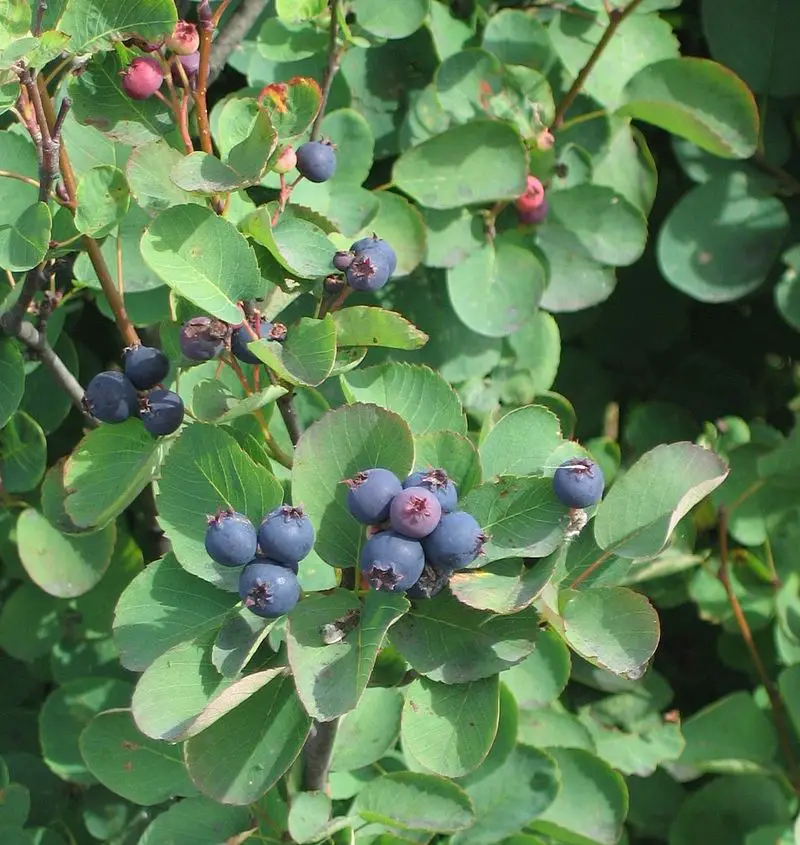
Saskatoon Berries
The Saskatoon serviceberry is another member of the rose family growing wild in Arizona. The berries are sweet, packed with antioxidants and vitamin C, and make a great treat right off the bush or cooked into pies or jams.
While these berries start off pink, they’re not ripe until they’re a dark blue or purple color. The stems are a deep brown that sometimes looks red. The simple green leaves grow on a large shrub.
Foragers looking for Saskatoon berries in Arizona will want to try their luck in July, though you may be able to find them as early as June or sticking around into August. If you find them in June, make sure they’ve ripened to their darker color.

Red Chokeberry
Native to Eastern Canada and Northern America, this deciduous shrub provides four-season interest with its beautiful blooms, berries, foliage, and fall colors. It tolerates a wide range of habitats and thrives in wet areas, such as pine flatwoods, seepage swamps, and wetlands, as well as dry open woods and low areas. In the landscape, it grows into dense colonies to protect soils and shorelines from erosion while providing food for wildlife.
In the spring, a profusion of white to light pink flowers bloom among the dark green foliage. These are followed by juicy, glossy red berries that persist into winter. Red chokeberry fruits are smaller than those of black chokeberry (Aronia prunifera), with 30 or more berries per cluster and a slightly less acidic taste. The berries are also much more nutritious, as they contain high levels of antioxidants.
While edible, it is important to know that the fruit seeds can be toxic if consumed in large quantities. They contain trace amounts of cyanide, which can cause poisoning if not ingested in small quantities with other foods. Therefore, you should always carefully inspect the berries to ensure they are ripe and clean before eating them.
Other Wild Food

Prickly Pear Cactus Fruits
The prickly pear cactus is an iconic desert plant that bears edible fruit. These bright red berries, known as tunas, grow on the pads of the cactus. When ripe, they can be harvested and enjoyed.
Prickly Pear fruits are known for their unique flavor profile, combining a delicate sweetness with a hint of tartness. They are often described as a cross between watermelon and bubblegum, offering a refreshing and pleasantly surprising taste. These wild fruits can be used in various culinary creations, from jams, jellies, and syrups to cocktails, sorbets, and even savory dishes like salsas and marinades.
Aside from their delightful taste, Prickly Pear fruits boast numerous health benefits. They are rich in essential nutrients, including vitamin C, vitamin B6, dietary fiber, and antioxidants.
When foraging for Prickly Pear cactus fruits, it is important to prioritize sustainable practices to ensure the continued growth and vitality of these remarkable plants. It takes three or four years for these plants to grow before they start producing fruits. It would be a shame for one of these plants that’s fruiting to get damaged. Take care not to damage the cactus or surrounding vegetation while harvesting the fruits. Use designated paths and avoid over-picking from a single plant. Protect yourself by wearing thick gloves, long-sleeved shirts, and pants to avoid getting pricked by the cactus spines or glochids.
Gently twist or cut the fruits from the cactus pad using pruners or a knife. Place them in a basket or container, being mindful of any spines that may still be present.
You can find these berries ripe throughout the month of August. The middle of the month is usually the best time. Make sure to look the fruit over thoroughly. When ripe, the fruit will be fully red. If you see some green spots, leave the fruit to ripen further.
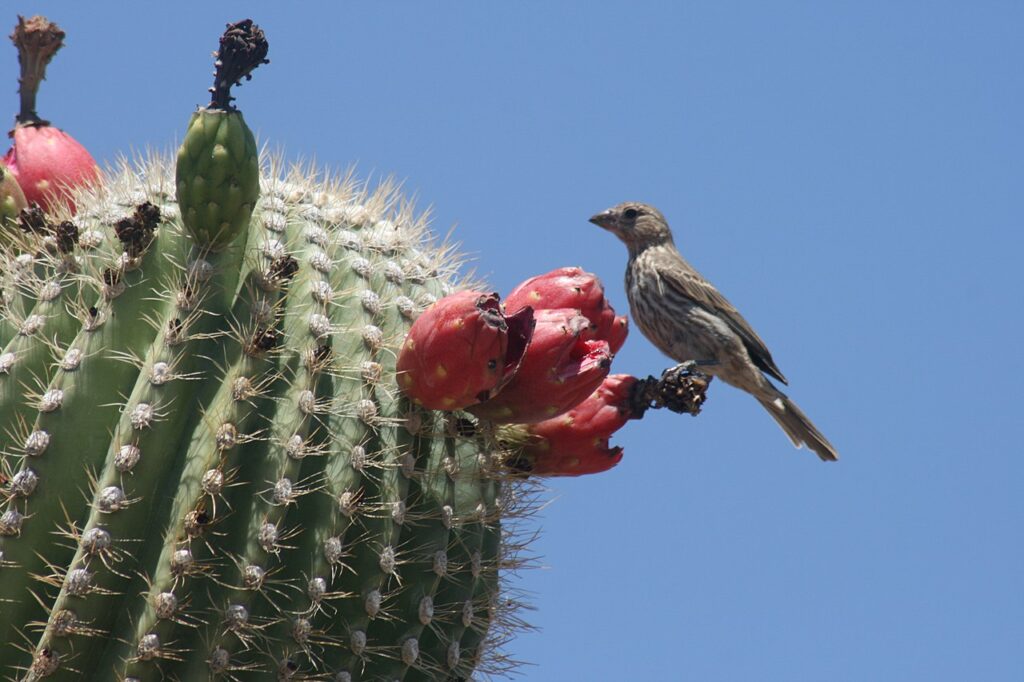
Saguaro Cactus Fruits
If you don’t live in the Sonoran Desert, you may not know the term saguaro, but you’ve likely seen the familiar cactus depicted in movies and television. Saguaro cactus are typically 40 feet tall, with the highest one recorded reaching 78 feet high. These cacti have spines along their rough green skin. They have a main trunk with branches growing off the sides that turn up toward the sky, often appearing like arms. What you may not have seen in a Western movie is that from May to July, the Saguaro cactus grow crowns of fresh fruit. They’re often well out of reach at 20 feet or more off the ground, so it’s common for the birds to get the fruit before humans reach it. The delicious fruit is eaten by slicing it in half and eating the pulpy center, which is loaded up with tiny black seeds.
Saguaro fruit is protected in the state of Arizona by The Native Plant Protection Act. Anyone wanting to harvest Saguaro fruits will need a permit. This makes fresh saguaro fruit a particularly rare treat.
Are Cacti Edible? What Kind Of Cactus Can You Eat?
Be Cautious When Hiking in Arizona
Keep in mind that hiking in Arizona comes with its own set of precautions. You need to be aware of dangers like poison oak, scorpions, and snakes. Flash floods are a major danger in many parts of Arizona.
You also need to watch out for poisonous berries and other plants that may be dangerous to ingest. Proper identification is crucial when foraging for wild berries. It is essential to differentiate between edible and non-edible species to ensure a safe and enjoyable experience.
Before venturing into the wilderness, familiarize yourself with the native plants and berries of the region. Local field guides or online resources specific to Arizona’s flora can provide valuable information on identifying different types of berries. Always use at least two sources to correctly identify a plant you plan to eat. Pay attention to the overall appearance of the plant. Note the size, shape, and color of the leaves, flowers, and fruits.
Some of the plants you’ll want to avoid ingesting in Arizona include oleander, dumb canes, Mexican bird of paradise, silverleaf nightshade, spectacle fruit, colorado desert mistletoe, and Persian cyclamen.
Enjoy the Wild Berries in Arizona’s Unique Landscapes
Arizona is a beautiful state full of diverse landscapes. Foraging for wild berries in Arizona is a journey that immerses you in the natural beauty of the region. From the iconic prickly pear cactus fruits to the delicate wild raspberries and blackberries, the diverse array of edible plants offers a unique culinary experience. Remember to exercise caution, consult local guides, and respect the environment while exploring the wilderness. So, lace up your hiking boots and embark on an adventure to savor the taste of Arizona’s wild berries, connecting with the land and its native flora along the way.
Recent Posts
The only venomous snakes in Washington State are Northern Pacific Rattlesnakes. The Northern Pacific Rattlesnake (Crotalus oreganus oreganus) is a sub-species of the Western Rattlesnake. Anyone...
Skunks are not classified as true hibernators. But they go into a state of torpor when the weather gets cold. Skunks are light sleep hibernators, along with opossums, bears, and raccoons. ...
